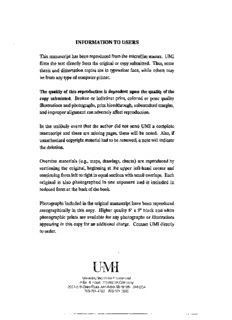Table Of ContentINFORMATION TO USERS
This manuscript has been reproducedfromthe microfilmmaster. UMI
filmsthe text directly from the originalor copysubmitted. Thus, some
thesis and dissertation copiesare in typewriterface, while others may
be from any typeofcomputerprinter.
The quality of this reproduction is dependent upon the quality of the
copy submitted. Broken or indistinct print, colored or poor quality
illustrations and photographs,printbleedthrough,substandard margins,
and improperalignment canadverselyaffectreproduction.
In the unlikely event that the author did not send UMI a complete
manuscript and there are missing pages, these will be noted. Also,if
unauthorized copyrightmaterial hadtobe removed, a note will indicate
the deletion.
Oversize materials (e.g., maps, drawings, charts) are reproduced by
sectioning the original, beginning at the upper left-hand corner and
continuing from left to rightinequalsectionswith small overlaps. Each
original is also photographed in one exposure and is included in
reducedform at the backofthe book.
Photographs included in the originalmanuscripthave been reproduced
xerographically in this copy. Higher quality 6" x 9" black and white
photographic prints are available for any photographs or illustrations
appearing in this copyfor an additionalcharge. Contact UMI directly
to order.
U·IvI·i
UniversityMicrofilms lnternatronal
ABell&HowellInformation Company
300 North Zeeb Road.AnnArbor.MI48106-1346USA
313/761-4700 800/521-0600
- - --- - ---- - ----_.- -----------
Order Number 9129619
Application of a novel multiple-scattering approach to
photoelectron diffraction and Auger electron diffraction
Kaduwela, Ajith P., Ph.D.
University of Hawaii, 1991
U·Ivl·I
300N.ZeebRd.
AnnArbor,MI48106
APPLICATION OF A NOVEL MULTIPLE-SCATTERING APPROACH TO
PHOTOELECTRON DIFFRACTION AND AUGER ELECTRON DIFFRACTION
A DISSERTATION SUBMITTED TO THE GRADUATE DIVISION OF THE
UNIVERSITY OF HAWAII IN PARTIAL FULFILLMENT OF THE
REQUIREMENTS FOR THE DEGREE OF
DOCTOR OF PHILOSOPHY
IN
CHEMISTRY
MAY 1991
By
Ajith P. Kaduwela
Dissertation Committee:
Charles S." Fadley, Chairperson
John D. Head
Che-Chen Chang
William L. Pong
James W. Holm-Kennedy
iii
DEDICATION
I dedicate this dissertation to my mother Mrs. G. N. Kaduwela and
my father Mr. P. K. Kaduwela for their love and guidance; to my wife
Arunika for her love and endurance.
iv
ACKNOWLEDGMENTS
I thank Professor Charles S. Fadley for his valuble advice and
support; Professor John D. Head for his numerous attempts to teach me
theoretical and computational chemistry; Professor John J. Rehr and
Dr. Jose Mustre de Leon for a very productive collaboration; Dr. Jurg
Osterwalder and Dr. Daniel J. Friedman for their assistance with
mathematics and computer programming; Mr. Gregory S. Herman and Mr.
Yong-Joo Kim for their help with computations; Mr. Donald Cole and his
associates for keeping the computers alive and well connected to the
outside world; members of the Fadley group for being helpful,
understanding and accomodating.
This work was supported by the Office of Naval Research (Contract
No. OOOl4-87-k-OSl2) and the National Science Foundation (Grant
CHE-83-20200). The calculations discussed here were performed at the
San Diego Supercomputing Center.
v
ABSTRACT
We apply a new separable-Green's-function matrix method due to
Rehr and Albers (Phys. Rev. B41 (1990) 8139) to a multiple scattering
treatment of photoelectron diffraction and Auger electron diffraction.
This cluster-based method permits building up successive orders of
scattering and judging the approach to convergence in a convenient and
time-saving way. We include multiple scattering up to tenth order and
can treat photoelectron emission from any initial state (s, p, d, or
f) with full final-state interference, as well as Auger emission in
the s-final-state approximation. This new approach is used to
simulate emission from linear and bent chains of atoms, from epitaxial
overlayers and multilayer substrates and from atomic and molecular
adsorbates. The method appears to have a very broad range of utility.
We also discuss the types of geometric structures for which multiple
scattering effects must be considered, and the nature of the effects
expected.
vi
TABLE OF CONTENTS
DEDICATION iii
ACKNOWLEDGEMENTS iv
ABSTRACT v
LIST OF TABLES x
LIST OF FIGURES xi
LIST OF ACRONYMS xxiv
CHAPTER 1. GENERAL INTRODUCTION 1
CHAPTER 2. THEORETICAL AND COMPUTATIONAL METHODOLOGy 16
2.1. INTRODUCTION 16
2.2. SINGLE-SCATTERING CLUSTER METHOD IN THE PLANE-WAVE LIMIT..17
2.3. SPHERICAL-WAVE AND MULTIPLE-SCATTERING MODIFICATIONS 20
2.4. APPLICATION OF THE SEPARABLE GREEN'S FUNCTION APPROACH OF
REHR AND ALBERS TO SINGLE· AND MULTIPLE-SCATTERING 22
2.4.1. The General Single-Scattering Intensity in
Photoelectron Diffraction 37
2.4.2. Single-Scattering Intensity for an s-Wave
Final State 47
2.4.3. Single-Scattering Intensity for a s-Emission into a
p-Wave Final State 49
2.4.4. Single-Scattering Intensity for p Emission in to
sand d Final state Channels 54
vii
2.4.5. Multiple-Scattering Intensity from a General
Initial State 58
2.4.6. Inclusion of Inelastic Scattering, Vibratonal Effects,
Instrumental Angular Averaging and Unpolarized
Radiation 66
2.4.7. Comparison to the Multiple-Scattering Treatment by
Barton and Shirley 75
2.5. COMPUTATIONAL DETAILS OF IMPORTANT INTERMEDIATE
QUANTITIES 82
2.5.1. Polynomial Part of the Spherical Hankel Function C£
(n)
and its Derivatives C 83
1
2.5.2. Euler Angles, a,/3,'Y 85
1
2.5.3. Rotation Matrix, R ,(a,/3,'Y) 88
IJIJ
2.5.4. Gaunt Coefficients, <1~.IIOI£.m.> 99
t1. 1.1.
2.5.5. Associate Legendre Polynomials, p1ml(coS8) 91
2.6. USER'S GUIDE TO THE FORTRAN CODE 92
2.6.1. General Structure of the FORTRAN code in Detail 93
2.6.2. Scanned-Angle and Scanned-Energy Photoelectron
Diffraction 98
2.6.3. Scanned-Angle Auger Electron Diffraction 112
2.6.4. Possible Methods for Accelerated Geometry
Optimization 114
2.7. COMPUTING ENVIRONMENT , 119
2.7.1. Cxay X-MP/48 (CTSS) 119
2.7.2. Cray Y-HP/864 (lJNICOS) 121
2.7.3. Sun SPARCstation (SunOS) 121
Description:USER'S GUIDE TO THE FORTRAN CODE. 92. 2.6.1. General . lower-order spherical wave approximation) are shown for energies of. 50-950 eV. 160 .. electron in an outer subshell n3~3' finally leaving two holes in outer shells: (1-7) . L.-G. Peterson, S. Kono, N.F.T. Hall, C.S. Fadleyand. J.B. Pendry

